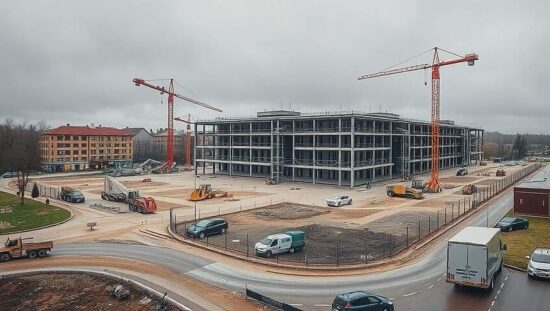Official data released this week by the Statistical Federal Office (Destatis) indicates a significant surge in housing construction approvals across Germany, raising questions about the efficacy of existing policies and the potential for continued market volatility. September 2025 witnessed the authorization of 24,400 new residential units, a remarkable 59.8% increase compared to the exceptionally low figures recorded in September 2024 – a month now identified as the lowest for approvals since January 2012.
The rebound is partly attributable to the abnormally depressed levels of construction activity seen in the same period last year, but also signals a potential shift in sentiment amongst developers, potentially driven by government incentives or evolving demographic needs. New-build approvals experienced a particularly dramatic increase, jumping 80.1% year-on-year to 20,900. Conversely, approvals for residential units stemming from the conversion or renovation of existing buildings declined slightly, suggesting a potential bottleneck or changing priorities within the renovation sector.
Accumulating data from January to September 2025 show a broader trend of increasing construction activity. A total of 175,600 housing units, encompassing both new builds and renovations, were approved – 11.7% higher than the corresponding period in 2024. The increase is heavily skewed towards new construction, with 142,600 units approved, a 14.2% rise fueled by a notable 17.4% increase in approvals for single-family homes. While approvals for two-family dwellings saw a slight decline, multi-family housing approvals demonstrated robust growth, climbing 13.0% to 93,100, potentially reflecting a move towards denser urban development. Approvals for student housing also witnessed a substantial rise of 55.9%.
However, the figures detailing approvals within non-residential buildings present a more complex picture. Approvals for residential units within these structures, which include accommodations for caretakers or those integrated above commercial spaces, fell by 14.5%, suggesting a potential downturn in this niche development area. While renovations within existing residential and non-residential buildings did see a modest increase (3.9% over the year), the overall trend underscores a dependency on new construction to meet ongoing housing demand.
Analysts are now scrutinizing these figures to evaluate the long-term impact on affordability and the sustainability of construction practices. Concerns remain about whether the current pace of approvals can be maintained, particularly given ongoing challenges pertaining to rising material costs, skilled labor shortages and bureaucratic hurdles. Furthermore, the reliance on new builds, while presently inflating approval numbers, raises questions regarding the potential for future market corrections and the long-term stability of the German housing sector. The government’s stated goals of increasing social housing provision remain, as yet, unclearly addressed by these latest development approvals.





